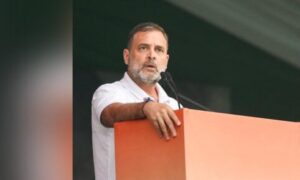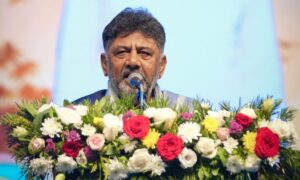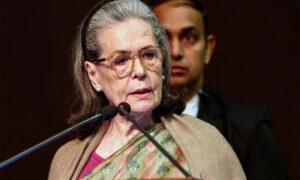By Kartikeya Singh
In what journalists and political pundits in India are calling a “saffron wave,” election results from five Indian states have given a big bump to the ruling Bharatiya Janata Party (BJP). When results were announced on Sunday, the biggest spoils of war went to the BJP, with landslide victories in both massive Uttar Pradesh (UP) and smaller Uttarakhand and a competitive showing in Manipur, a state where it has never previously had a presence. The latter is particularly important given the inroads the party wants to make in India’s northeastern states. The Indian National Congress (INC) managed to regain control of Punjab, which had previously been governed by the BJP in coalition with a regional party, while the three-year-old Aam Aadmi Party (AAP) did not manage to upset the current political order. Behind the saffron wave, the truth is that without a majority in the upper house of Parliament, the Modi government must still rely on nonlegislative activity to push through its development agenda. A big win in UP provides a boost to continue to create innovative central programs in an expanding map of friendly state governments that will be crucial for a BJP victory in the next national election in 2019.
The Wadhwani Chair at CSIS has closely tracked the status of economic reforms promised by the government of Prime Minister Narendra Modi. Reforming a lumbering economy like India’s is not easy and often requires both the cooperation of states and a majority in both the upper and lower houses of Parliament. While the BJP secured a majority in the lower house in the 2014 national elections, the party and its coalition partners currently only control 74 of the 245 total seats in the upper house. Some pundits might be quick to say that the sweeping victory in Uttar Pradesh, India’s most populous state, gives the BJP a stronger hand to push through national reforms. However, as we have reported before, the math still does not work in Prime Minister Modi’s favor. Even with the up to nine seats the BJP is set to gain in the upper house thanks to the wins in Uttar Pradesh and Uttarakhand, the party falls far short of a majority required to easily pass legislation. This means he will either need to work with nonaligned parties to bring them on board or pursue nonlegislative reform efforts.
The BJP’s historic victory in Uttar Pradesh suggests Indians’ hunger for bold reforms and effective governance with results the electorate can see. Last November, Modi took a gamble on removing most Indian currency from circulation, causing disruption to daily life for hundreds of millions. Perhaps unexpectedly, demonetization may have given the BJP’s image a positive boost as a party aggressively addressing corruption. It may very well be that in Uttar Pradesh, a state with a contentious political culture based on caste and religion, people voted for better, more effective governance to facilitate development. Without control of the upper house but with a mandate to march on in areas he can create change, what might Modi do with this victory? A few examples of what the areas of activity might be (and how they may have already impacted the state of Uttar Pradesh) are outlined below.
- Financial Inclusion: by accelerating financial inclusion in the country through the Pradhan Mantri Jan Dhan Yojana (Prime Minister’s People’s Banking Program), the prime minister reaffirmed his image as a leader for the poor. With over 278 million bank accounts opened through the program in the last three years, this program opened the door for more efficient transfer of subsidies and brought millions of people into the formal banking sector. According to one survey, by the second half of 2015, approximately 19 percent of Uttar Pradesh’s population still remained unbanked. This leaves some room for continued expansion of this central government program.
- Universal Basic Income: the idea of doing away with India’s unwieldy and burgeoning welfare system and addressing India’s poverty through the introduction of a universal basic income has been around for some time. However, this requires political will and an agreement with a state to share the burden of rolling out such a program. With the win in a large populous state like Uttar Pradesh and control of the center, Modi may have a chance to continue his financial reform experiments by using Uttar Pradesh as a pilot. Success in this initiative could open the door for more BJP-ruled states to take it up, furthering state-led innovation, an approach Modi seems to favor.
- Universal Energy Access: state governments control electricity tariffs, but the center has responsibility for production of coal—still the largest energy resource for power—through state-owned Coal India Limited and for generation of electricity through the National Thermal Power Corporation. Perhaps most importantly for the nearly 300 million people without reliable electricity access in India, the center has the power to extend transmission lines through a unified national grid. Prime Minister Modi has promised to bring power to every village by early 2018. As of January 31, 2017, Uttar Pradesh has approximately 65 villages that still need electricity (keeping in mind of course that only 10 percent of households in a village need to have access to electricity in order to be considered electrified). This is down from 224 unelectrified villages in the state in April 2016, suggesting that considerable progress has been made under this central government program. Expanding electricity access will also likely make it easier to deregulate pricing on kerosene, a fuel largely used by the rural poor for lighting in the absence of electricity.
- Clean Cooking Fuels: nearly 75 percent of India’s people still burn biomass as a cooking fuel. Use of biomass not only poses health hazards (predominantly for women) but also has a negative impact on India’s air quality. To bring more people access to clean cooking fuel the Pradhan Mantri Ujjwal Yojana (Prime Minister’s Bright Program) aims to provide 50 million households below the poverty line access to liquefied petroleum gas. Perhaps the largest welfare program carried out by the central Ministry of Petroleum & Natural Gas, Uttar Pradesh has been one of the first states to benefit from this program. The success of the program will likely provide the basis for its continued rollout in other states and ease pressure on the central government to deregulate natural gas prices.
Despite the BJP victories in this election cycle, without support from regional parties, the Modi government still lacks the required number of seats in the upper house of Parliament to pursue an aggressive reform agenda through legislation. The programs outlined above and the strategic way in which they were rolled out in Uttar Pradesh in the lead up to these elections offer a window into Prime Minister Modi’s strategy to push through large nonlegislative development programs. These programs have a demonstrative impact on peoples’ livelihoods and may allow the Modi government to garner their support for bolder reforms. In addition, this strategy may help build a collection of BJP-allied states where such reforms can be unfurled.
Kartikeya Singh is a fellow and deputy director of the Wadhwani Chair in U.S.-India Policy Studies at the Center for Strategic and International Studies in Washington, D.C.
The commentary is produced by the Center for Strategic and International Studies (CSIS), a private, tax-exempt institution focusing on international public policy issues. Its research is nonpartisan and nonproprietary. CSIS does not take specific policy positions. Accordingly, all views, positions, and conclusions expressed in this publication should be understood to be solely those of the author(s).
© 2017 by the Center for Strategic and International Studies. All rights reserved.
Photo credit: CHANDAN KHANNA/AFP/Getty Image
(This article first appeared on the Center for Strategic and International Studies (CSIS). To read the original article click Here.)



















